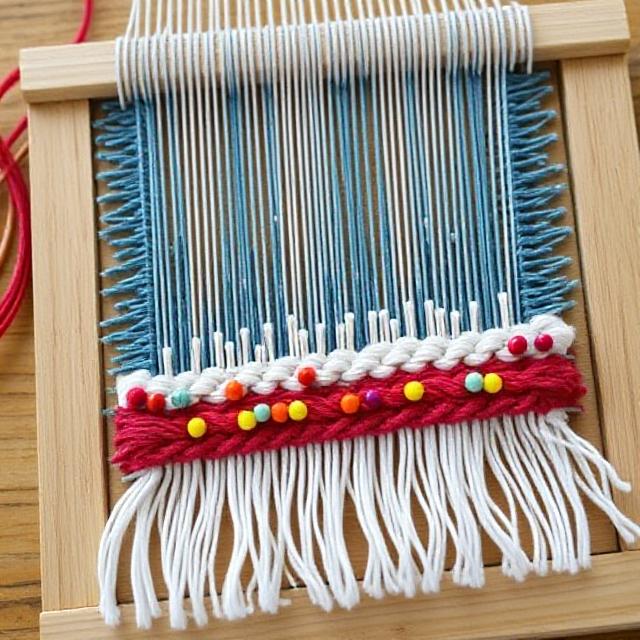Weaving has been an integral part of human culture for thousands of years, serving both practical and artistic purposes. Today, with the resurgence of fiber arts and the rise of easy-to-use weaving tools, pin loom projects have become a popular way for beginners and seasoned crafters alike to explore textile arts. Compact, portable, and versatile, pin looms are perfect for creating a variety of Pin Loom Projects that range from decorative items to functional accessories. In this article, we will explore the world of pin loom projects, discussing what pin looms are, their benefits, and a wide array of creative project ideas to inspire your next craft adventure.
What Is a Pin Loom?
A pin loom is a small, portable weaving frame that uses a grid of pins or nails to hold warp threads in place while weavers create woven structures with weft yarns. Typically, pin looms are made from wood, plastic, or metal, with a grid of evenly spaced pins arranged in rows and columns. The size can vary, but most pin looms are compact enough to fit in the hand or be easily carried around.
The simplicity of pin looms makes them ideal for beginners, children, and those interested in small-scale weaving Pin Loom Projects. They are especially popular for creating mini rugs, tapestries, bookmarks, and jewelry. Since their design promotes quick results and low yarn consumption, pin looms are a cost-effective way to experiment with weaving techniques and develop new skills.
Benefits of Using a Pin Loom
- Portability: Their small size makes pin looms easy to transport, allowing for weaving on the go, during travel, or while waiting.
- Ease of Use: The straightforward setup and operation make pin looms accessible for all ages and skill levels.
- Speed: Pin Loom Projects can be completed relatively quickly, making them satisfying and motivating for crafters.
- Versatility: They support a variety of weaving techniques, including plain weave, rya, tapestry, and more complex patterns.
- Cost-Effective: Generally affordable, they provide a low-cost entry point into fiber arts.
- Educational Tool: Excellent for teaching children or beginners about weaving fundamentals, patterns, and color theory.
Popular Pin Loom Projects
Now that we understand what pin looms are and their advantages, let’s explore some popular and inspiring Pin Loom Projects that you can create with this versatile tool.
1. Miniature Rugs and Mats
One of the most classic pin loom projects is the tiny rug or mat. Using thicker yarns or roving, you can create small rugs that serve as decorative pieces or functional doormats. Experiment with different patterns—stripes, chevrons, or geometric shapes—to add visual interest. These rugs are perfect for dollhouses, as coasters, or as wall hangings.
2. Tapestries and Wall Hangings
Create vibrant, textured tapestries by weaving colorful yarns or fibers onto your pin loom. Incorporate techniques such as rya (fringe weaving) or soumak (wrap stitch) for added texture. These woven artworks can be framed or hung directly for unique wall decor.
3. Bookmark Weaving
Small, flat Pin Loom Projects like bookmarks are ideal for pin looms. Use fine yarns or embroidery threads to produce intricate patterns, monograms, or abstract designs. These make thoughtful gifts and can be personalized with embroidery or embellishments.
4. Jewelry and Accessories
Pin looms are perfect for creating woven jewelry pieces such as bracelets, chokers, or earrings. Use thinner yarns or thread-like fibers, and experiment with color combinations and weaving techniques. Add clasps, beads, or charms for a finished look.
5. Coasters and Placemats
Functional and decorative, coasters and placemats woven on a pin loom can enhance your table setting. Use natural fibers like jute, hemp, or cotton for durability, and incorporate patterns or textures to match your home decor.
6. Small Pouches and Bags
By weaving fabric sections and sewing them together, you can create small pouches, coin purses, or cosmetic bags. Incorporate a zipper or drawstring for closure. These projects are practical, stylish, and showcase your weaving skills.
7. Felted and Textured Art Pieces
Combine weaving with felting by adding wool roving to your woven surface and then felting it for a plush, textured effect. This technique produces tactile art pieces or decorative accents.
Techniques and Tips for Pin Loom Projects
- Choosing Yarn: The type of yarn you select influences the texture and appearance of your project. Thicker yarns create plush, chunky effects, while fine threads produce intricate details.
- Color Planning: Planning your color palette beforehand helps in creating harmonious or striking designs. Consider color theory principles for more impactful results.
- Pattern Design: Sketch your pattern on paper before weaving, especially for complex designs like geometric motifs or images.
- Weaving Techniques: Explore different weaving styles—plain weave, twill, rya, soumak—to add variety and texture.
- Finishing Touches: Secure the ends with knots, weave tails into the project, or add embellishments like beads or embroidery for a polished look.
- Experimentation: Don’t be afraid to try new fibers, color combinations, or weaving methods to develop your unique style.
Getting Started with Pin Loom Projects
To begin your pin loom journey, you’ll need a basic pin loom frame, some yarn or fibers, scissors, and optional embellishments. Many craft stores sell pre-made pin looms, or you can make your own from household materials. Start with simple Pin Loom Projects like a small coaster or bookmark, and gradually progress to more complex pieces as you gain confidence.
Online tutorials, craft books, and video demonstrations are abundant resources for learning new techniques and inspiring ideas. Joining weaving communities and social media groups can also provide support, feedback, and fresh project ideas.
Conclusion
Pin loom projects open a world of creative possibilities for fiber enthusiasts of all ages and skill levels. Whether you’re creating decorative wall hangings, practical accessories, or playful art pieces, the elegance and simplicity of pin loom weaving make it an enjoyable and rewarding craft. From tiny rugs to intricate jewelry, the versatility of the pin loom continues to inspire new ideas and techniques.
Embrace the tactile joy of weaving, experiment with colors and textures, and let your imagination guide your Pin Loom Projects. As you explore pin loom projects, you’ll develop new skills, produce beautiful handcrafted items, and enjoy the meditative process of weaving—one pin at a time.
If you’re interested in visual aids or step-by-step tutorials for specific pin loom projects, numerous online resources and craft communities can offer detailed guidance. Happy weaving!



